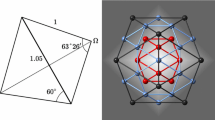Abstract
A characteristic feature of I—III–VI ternary chalcogenide compounds, which has a significant effect on the possibility of controlling the functional properties of materials on their base, is a strong tendency toward a deviation from stoichiometry. In this paper, we substantiate the existence of ternary semiconductor compounds with ordered vacancies in nanocrystals of the I—III–VI system using the triangulation method (Goryunova method for predicting the composition of diamond-like semiconductors). Vacancies are presented as a pseudoelement of the periodic system of the zero group assuming the formation of electrically neutral defect complexes consisting of a vacancy in the position of the group-I atom and a doubly ionized antistructural defect. In this case, the compound is considered from the standpoint of a concentration tetrahedron, and triangulation operations pass into tetrahedral operations. In the presence of such a “virtual” element, a set of ternary compounds known from publications with an ordered content of vacancies corresponding to semiconductors having four bonds per individual atom is determined instead of a single composition in the I—III–VI2 system.


Similar content being viewed by others
REFERENCES
C. R. Kagan, E. Lifshitz, E. H. Sargent, and D. V. Talapin, Science 353, 885 (2016). https://doi.org/10.1126/science.aac5523
M. K. Choi, J. Yang, T. Hyeon, and D. H. Kim, npj Flexible Electron. 2, 10 (2018). https://doi.org/10.1038/s41528-018-0023-3
F. P. de Arquer, A. Armin, P. Meredith, and E. H. Sargent, Nat. Rev. Mater. 2, 16100 (2017). https://doi.org/10.1038/natrevmats.2016.100
B. Pelaz, C. Alexiou, R. A. Alvarez-Puebla, F. Alves, A. M. Andrews, S. Ashraf, L. P. Balogh, L. Ballerini, A. Bestetti, C. Brendel, et al., ACS Nano 11, 2313 (2017). https://doi.org/10.1021/acsnano.6b06040
A. Sharan, F. P. Sabino, A. Janotti, N. Gaillard, T. Ogitsu, and J. B. Varley, J. Appl. Phys. 127, 065303 (2020). https://doi.org/10.1063/1.5140736
J. Du, R. Singh, I. Fedin, A. S. Fuhr, and V. I. Klimov, Nat. Energy. 5, 409 (2020). https://doi.org/10.1038/s41560-020-0617-6
G. Regmi, A. Ashok, P. Chawla, P. Semalti, S. Velumani, S. N. Sharma, and H. Castaneda, J. Mater. Sci.: Mater. Electron. 31, 7286 (2020). https://doi.org/10.1007/s10854-020-03338-2
D. Aldakov, A. Lefrancois, and P. Reiss, J. Mater. Chem. C 1, 3756 (2013). https://doi.org/10.1039/C3TC30273C
D. S. Mazing, A. A. Karmanov, L. B. Matyushkin, O. A. Aleksandrova, I. A. Pronin, and V. A. Moshnikov, Glass Phys. Chem. 42, 497 (2016). https://doi.org/10.1134/S1087659616050114
D. S. Mazing, O. A. Korepanov, O. A. Aleksandrova, and V. A. Moshnikov, Opt. Spectrosc. 125, 773 (2018). https://doi.org/10.1134/S0030400X1811019X
O. A. Korepanov, D. S. Mazing, O. A. Aleksandrova, V. A. Moshnikov, A. S. Komolov, E. F. Lazneva, and D. A. Kirilenko, Phys. Solid State 61, 2325 (2019). https://doi.org/10.1134/S1063783419120217
S. Ghosh, S. Mandal, S. Mukherjee, C. K. De, T. Samanta, M. Mandal, D. Roy, and P. K. Mandal, J. Phys. Chem. Lett. 12, 1426 (2021). https://doi.org/10.1021/acs.jpclett.0c03519
O. Yarema, M. Yarema, and V. Wood, Chem. Mater. 30, 1446 (2018). https://doi.org/10.1021/acs.chemmater.7b04710
A. C. Berends, M. J. Mangnus, C. **a, F. T. Rabouw, and D. C. de Mello, J. Phys. Chem. Lett. 10, 16006 (2019). https://doi.org/10.1021/acs.jpclett.8b03653
A. D. Leach and J. E. Macdonald, J. Phys. Chem. Lett. 7, 572 (2016). https://doi.org/10.1021/acs.jpclett.5b02211
N. A. Goryunova, Complex Diamond-Like Semiconductors (Sov. Radio, Moscow, 1968) [in Russian].
C. Coughlan, M. Ibáñez, O. Dobrozhan, A. Singh, A. Cabot, and K. M. Ryan, Chem. Rev. 117, 5865 (2017). https://doi.org/10.1021/acs.chemrev.6b00376
S. Jeong, H. C. Yoon, N. S. Han, J. H. Oh, S. M. Park, B. Min, Y. R. Do, and J. K. Song, J. Phys. Chem. C 121, 3149 (2017). https://doi.org/10.1021/acs.jpcc.7b00043
J. M. Merino, S. Mahanty, M. Leon, R. Diaz, F. Rueda, and J. M. De Vidales, Thin Solid Films 361, 70 (2000). https://doi.org/10.1016/S0040-6090(99)00771-3
O. Yarema, M. Yarema, D. Bozyigit, W. M. Lin, and V. Wood, ACS Nano 9, 11134 (2015). https://doi.org/10.1021/acsnano.5b04636
S. B. Zhang, S. H. Wei, and A. Zunger, Phys. Rev. Lett. 78, 4059 (1997). https://doi.org/10.1103/PhysRevLett.78.4059
S. B. Zhang, Phys. Rev. B 57, 9642 (1998). https://doi.org/10.1103/PhysRevB.57.9642
L. B. Matyushkin and V. A. Moshnikov, Semiconductors 51, 1337 (2017). https://doi.org/10.1134/S106378261710013X
A. N. Aleshin, I. P. Shcherbakov, D. A. Kirilenko, L. B. Matyushkin, and V. A. Moshnikov, Phys. Solid State 61, 256 (2019). https://doi.org/10.1134/S1063783419020021
T. Omata and K. Nose, J. Appl. Phys. 105, 073106 (2009). https://doi.org/10.1063/1.3103768
Author information
Authors and Affiliations
Corresponding authors
Ethics declarations
The authors declare that they have no conflicts of interest.
Additional information
Translated by A. Ivanov
Rights and permissions
About this article
Cite this article
Mazing, D.S., Aleksandrova, O.A. & Moshnikov, V.A. Model of the Structural Ordering of Vacancies and the Formation of a Family of Ternary Compounds in I–III–VI Systems. J. Surf. Investig. 17, 1378–1382 (2023). https://doi.org/10.1134/S1027451023060356
Received:
Revised:
Accepted:
Published:
Issue Date:
DOI: https://doi.org/10.1134/S1027451023060356




